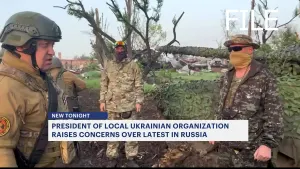More Stories
The United States and European Union on Friday announced a new partnership to reduce the continent's reliance on Russian energy, the start of a years-long initiative to further isolate Moscow after its invasion of Ukraine.
As part of the plan, the U.S. and other nations will increase liquified natural gas exports to Europe by 15 billion cubic meters this year, the White House said. Even larger shipments would be delivered in the future.
At the same time, they will try to keep their climate goals on track by powering gas infrastructure with clean energy and reducing methane leaks that can worsen global warming.
Although the initiative will likely require new facilities for importing liquified natural gas, the partnership is also geared toward reducing reliance on fossil fuels in the long run through energy efficiency and alternative sources of energy, according to the White House.
U.S. President Joe Biden was set to discuss the issue with Ursula von der Leyen, head of the European Union’s executive arm, before leaving for Poland, the final leg of his four-day trip.
Earlier this week, Von der Leyen said "we are aiming at having a commitment for additional supplies for the next two winters.” And Jake Sullivan, Biden’s national security adviser, recently told reporters that the administration wants to quickly “surge” gas to Europe.
Russian energy is a key source of income and political leverage for Moscow. Almost 40% of the European Union's natural gas comes from Russia to heat homes, generate electricity and power industry.
After leaving Brussels, Biden travels to Rzeszów in Poland, where U.S. troops are based roughly an hour's drive from the Ukrainian border. He'll get a briefing on the humanitarian response to the refugees streaming out of Ukraine and those still suffering inside the country. He'll also meet with U.S. service members from the 82nd Airborne Division, who serve alongside Polish troops.
Biden is then expected to continue on to Warsaw for talks Saturday with Polish President Andrzej Duda.
Before returning to Washington, the White House said, Biden will give an address "on the united efforts of the free world to support the people of Ukraine, hold Russia accountable for its brutal war, and defend a future that is rooted in democratic principles.”
While in Brussels, Biden participated in a trio of summits hosted by NATO, the Group of Seven industrialized nations and the European Union, all on Thursday. The extraordinary series of meetings reflects heightened concerns about the war in Ukraine, which has entered its second month.
Although Ukraine has resisted the Russian invasion much more successfully than initially expected, the conflict has become a grueling and bloody affair, with thousands of casualties on each side and millions of refugees fleeing the country.
Western leaders are also concerned that Russian President Vladimir Putin could use chemical or even nuclear weapons to regain momentum in the war.
Getting more liquefied natural gas to Europe could be difficult, even though the U.S. has been dramatically increasing its exports in recent years. Many export facilities are already operating at capacity, and most new terminals are still only in the planning stages.
Most U.S. shipments already go to Europe, according to the Center for Liquefied Natural Gas, an industry lobbying group. Although much of the supply is already contracted out to buyers, there's still opportunities to shift its destination.
“The U.S. is in a unique position because it has flexible LNG that can be rerouted to Europe or to Asia, depending on who’s willing to pay that price,” said Emily McClain, gas markets analyst at Rystad.
Even if the U.S. can ship more gas to Europe, the continent may struggle to receive it. Import terminals are located in coastal areas, where there are fewer pipeline connections for distributing it.
Even if all Europe’s facilities were operating at capacity, the amount of gas would likely be only about two-thirds of what Russia delivers through pipelines.
More from News 12
2:25

Westchester Ukrainian org chief questions validity of Putin-Wagner deal that ended brief uprising
1:54

Rockland residents show support for Ukraine as world marks 1 year since Russian invasion
2:23

Hudson Valley marks one year since Russia invaded Ukraine
1:59

15-year-old girl transfers to Hudson Valley to play basketball due to war in Ukraine

Zelenskyy thanks 'every American,' sees 'turning point'
